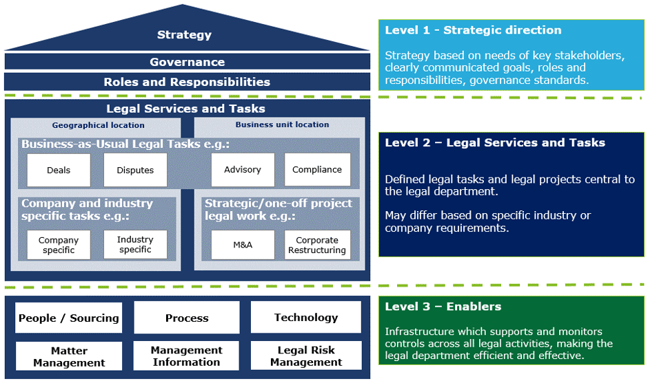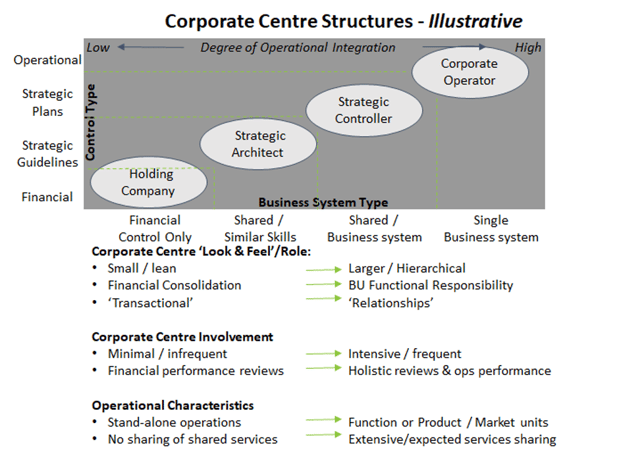Through our work with a number of organisations across the region – via our People, Process and Technology, and Managed Legal Services offerings – we’ve been exposed to different permutations and combinations of the legal operating model. We have picked out five key insights to share and which we think will be of interest for those in the legal industry.
What is an Operating Model?
First, what is an “operating model”? It is a term well known in the wider business realm and often a key strategy drive. A business’ operating model is essentially the combination of roles, skills, structures, processes, assets and technologies that allow an organisation to deliver on its strategy. It’s the way the business is set up to achieve its goals, and meet future challenges. As technology continues to drive innovation, businesses are adapting to this to ensure their operating model reflects the technological future.
In its most basic form, this means determining what capabilities need to be put in place, primarily from a people, process, technology and organisation perspective; supported with appropriate structure, responsibilities / accountabilities, governance and culture/values frameworks, to give the strategy every chance of succeeding. Holistically, the legal operating model may look something like diagram 1 below:
Diagram 1: Google / generalcounsel.nl
But while ‘theory’ and frameworks are all well and good, the success of any strategy ultimately comes down to the ability to execute against the plan. This is where we are finding that similarities in models and frameworks end, as there is no ‘one-size-fits-all’ approach.
5 Key Insights Shaping the Legal Operating Model
Here are five interesting insights that we’ve seen and heard ‘on our travels’ around the region concerning legal operating models. While these may not apply to all law firms or legal departments, we’ve noticed these trends applied broadly across the industry.
1. There’s no single ‘right’ legal operating model for the legal operations set-up.
What is clear is that the Corporate Centre structure, or desired corporate structure in the case of new tech or new business model players, of the organisation will significantly dictate the extent of in-house oversight and control.
Diagram 2: Google / Nolan Norton Institute; Korum Insights
A number of key questions are rhetorically answered, as the Corporate Centre’s level of interference / operational integration will usually dictate this. As can be seen in diagram 2 above, as you move from ‘bottom left’ to ‘top right’, the basis of how things interrelate and/or integrate changes:
- how to operate out of the Corporate Centre vs operate in the local jurisdiction;
- what services / activities are best done locally vs regionally;
- how to best manage a diverse team etc,
all greatly depend on the degree of operational integration and strategic diversity of the Corporate Centre’s portfolio.
2. Legal departments are increasingly expected to become more of a strategic partner to the business
A new-age legal department needs to participate more pro-actively in the revenue generating and commercial areas of the operation, and more and more we are seeing this become a part of legal operating models. Whereas, traditionally, an in-house legal operation might be viewed as more of a ‘back-office’ function, and one that behaves in a predominantly reactive manner. This form of ‘red-flag’ governance approach is changing into one that is far more responsive, involved ‘up-front’ and relevant. GCs and their teams are being asked to become practical ‘commercial enablers’.
Key questions we see GCs facing here usually relate to the required changing ‘dynamic’ of the function. It comes down to:
- what ‘we’ should or should not be involved in and therefore responsible for;
- how do we best work at the ‘coal face’ with the business;
- how to get timely visibility over what is going on;
- how to best staff-up for this;
- what is the most appropriate management hierarchy and/or legal span of control to deploy.
3. There is the reality that the legal department is not immune to budget and cost/expense control.
GCs are increasingly being asked to look at ways to do things more effectively and efficiently. Managing expenses and controlling costs has become another responsibility we’ve seen emerge in legal operating models. But, not surprisingly, this outlook and expectation is in stark contrast to point 2 above!
Key questions GCs are grappling with include:
- how to best deploy my budget to meet business requirements;
- where (and how) to pare back operations without impacting service expectation;
- which operations should be kept in-house vs outsourced;
- how to get good quality labour on an ‘on-demand’ basis;
- what process improvements and/or technology solutions may assist in improving productivity and efficiency and/or help to reduce lower value-add work;
- how to best oversee / manage the operation which has become leaner in structure.
4. These changing business expectations and market dis-aggregation / fragmentation mean that GCs are struggling with who to turn to and trust for advice and guidance.
Given these changing market dynamics, this is not a space that lawyers have historically played in and it’s not necessarily a skillset that sits comfortably in a GC’s toolbox. The rapid pace and ‘noise’ of new technologies, apps, AI, competition can be bamboozling and confusing, yet GC’s are expected to be ‘in the know’, to have a view, and ultimately to be able to come up with practical solutions.
In this scenario, it’s less about key questions and more about the feedback we hear, such as the importance of understanding upfront what the business expectation is of the legal operating model. Think ‘relevance’ and ‘Return on Investment’ (ROI), not billable hours; the value of peer education / discussion and beware the generalists and self-appointed experts who can only ‘talk the talk’ as success only comes with ‘walking the walk’…and lawyers are known not to suffer fools gladly.
5. The legal operating model is no longer just the domain for the multi-nationals and/or traditional regional operators.
The rapid growth of businesses which know no-boundaries, underpinned by technological advancements and access to remote legal talent pools, have witnessed the necessity of interim operating models, on more of a variable cost-base structure. This allows GCs to better manage for ‘hockey-stick’ growth, cater to differentiated market requirements and expectations and to focus on doing one’s job rather than constantly be interviewing for full-time resources.
Key questions other than who to use as a trusted partner include where to focus one’s effort; what work it is critical to keep in-house; how to ensure / oversee the quality of output; what is the maturity of each market we are / will be operating in and how to best structure for this, etc.
Please reach out to us if you would like to find out more about the legal operating model or if you wish to discuss your legal operating model with us.
KorumLegal offers a range of solutions in the legal operating model and legal operations space. We combine technology with smart process and legal consultants who are well-versed on legal operations and process to undertake advisory projects on process blueprint and or re-design or transformation.








